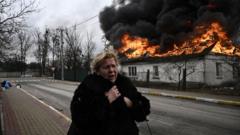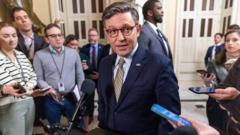In the week marking 1,000 days of the conflict, the landscape of the Ukraine-Russia war underwent dramatic shifts as Western nations intensified military support for Ukraine while Russia upped its nuclear rhetoric.
**Escalating Tensions in Ukraine: A Critical Week Marking 1000 Days of Conflict**

**Escalating Tensions in Ukraine: A Critical Week Marking 1000 Days of Conflict**
The Ukraine-Russia war has reached a significant milestone, as recent developments unveil the rising stakes involved.
The past week has been monumental for the Ukraine war, with major military escalations and geopolitical shifts signaling a deepening of hostilities and uncertainty in the region.
Amidst escalating tensions, the Western alliance has dramatically altered its approach to military support for Ukraine. Following the recent decision by U.S. President Joe Biden to authorize Ukraine the use of longer-range ATACMS missiles against targets in Russia, a notable shift occurred. Historically, Washington had denied such requests, but this pivot became evident over the weekend when reports indicated that Ukrainian forces launched ATACMS missiles into Russia’s Bryansk region, marking the first time American-made missiles had struck Russian territory in this conflict. Ukraine also deployed UK-sourced Storm Shadow missiles targeting the Kursk region, corresponding with the movement of Ukrainian troops into Russian-held areas.
Furthermore, Biden approved the use of anti-personnel landmines, a controversial yet practical measure aimed at fortifying defenses against Russian advances in Eastern Ukraine. These decisions collectively paint a picture of unwavering support from Western powers for Ukraine, indicating that allied nations are bolstering their military assistance as the conflict shows no signs of waning.
On the other hand, Russia responded with assertive threats and actions designed to underscore its nuclear capabilities. On the 1,000th day of the conflict, President Vladimir Putin revised Russia’s nuclear doctrine, signaling a lowered threshold for nuclear engagement in response to perceived attacks from non-nuclear states bolstered by a nuclear power. This shift in policy underscores a potentially existential risk for global security.
The Kremlin's announcement introduced a new missile system named "Oreshnik," with purported capabilities to deliver devastating strikes at unprecedented velocities. Such military advancements serve not only as a direct threat but also as a calculated warning to Ukraine and its allies, potentially aimed at headline-grabbing displays of power amid ongoing conflict.
The atmosphere surrounding these events is increasingly charged, with Russia framing the conflict as a “global” challenge, particularly as North Korean forces have reportedly entered the fray alongside Russian troops, raising the specter of an expanded geopolitical confrontation.
Amid these developments, domestic political shifts in the United States contribute to the urgency of current events. President-elect Donald Trump’s impending transition into office is believed to be a motivating factor for Biden's recent military support to Ukraine. Trump has asserted intentions to resolve the ongoing war quickly, potentially signaling forthcoming negotiations that could redefine territorial disputes.
Ukrainian leaders express a complex mixture of hope and caution regarding the prospect of changing leadership in Washington. Although President Zelensky has indicated that diplomatic resolutions may emerge sooner under Trump, concerns linger that the United States’ policy approach may shift under his administration, complicating Ukraine’s strategic posture.
This week’s rapid-fire developments are significant not just in military terms, but also in setting the stage for future diplomatic engagements that may emerge as the conflict progresses. As both sides prepare for potential escalations, the global community is left to grapple with the implications of a war that shows no sign of resolution while evolving in scope and consequence.
Amidst escalating tensions, the Western alliance has dramatically altered its approach to military support for Ukraine. Following the recent decision by U.S. President Joe Biden to authorize Ukraine the use of longer-range ATACMS missiles against targets in Russia, a notable shift occurred. Historically, Washington had denied such requests, but this pivot became evident over the weekend when reports indicated that Ukrainian forces launched ATACMS missiles into Russia’s Bryansk region, marking the first time American-made missiles had struck Russian territory in this conflict. Ukraine also deployed UK-sourced Storm Shadow missiles targeting the Kursk region, corresponding with the movement of Ukrainian troops into Russian-held areas.
Furthermore, Biden approved the use of anti-personnel landmines, a controversial yet practical measure aimed at fortifying defenses against Russian advances in Eastern Ukraine. These decisions collectively paint a picture of unwavering support from Western powers for Ukraine, indicating that allied nations are bolstering their military assistance as the conflict shows no signs of waning.
On the other hand, Russia responded with assertive threats and actions designed to underscore its nuclear capabilities. On the 1,000th day of the conflict, President Vladimir Putin revised Russia’s nuclear doctrine, signaling a lowered threshold for nuclear engagement in response to perceived attacks from non-nuclear states bolstered by a nuclear power. This shift in policy underscores a potentially existential risk for global security.
The Kremlin's announcement introduced a new missile system named "Oreshnik," with purported capabilities to deliver devastating strikes at unprecedented velocities. Such military advancements serve not only as a direct threat but also as a calculated warning to Ukraine and its allies, potentially aimed at headline-grabbing displays of power amid ongoing conflict.
The atmosphere surrounding these events is increasingly charged, with Russia framing the conflict as a “global” challenge, particularly as North Korean forces have reportedly entered the fray alongside Russian troops, raising the specter of an expanded geopolitical confrontation.
Amid these developments, domestic political shifts in the United States contribute to the urgency of current events. President-elect Donald Trump’s impending transition into office is believed to be a motivating factor for Biden's recent military support to Ukraine. Trump has asserted intentions to resolve the ongoing war quickly, potentially signaling forthcoming negotiations that could redefine territorial disputes.
Ukrainian leaders express a complex mixture of hope and caution regarding the prospect of changing leadership in Washington. Although President Zelensky has indicated that diplomatic resolutions may emerge sooner under Trump, concerns linger that the United States’ policy approach may shift under his administration, complicating Ukraine’s strategic posture.
This week’s rapid-fire developments are significant not just in military terms, but also in setting the stage for future diplomatic engagements that may emerge as the conflict progresses. As both sides prepare for potential escalations, the global community is left to grapple with the implications of a war that shows no sign of resolution while evolving in scope and consequence.




















